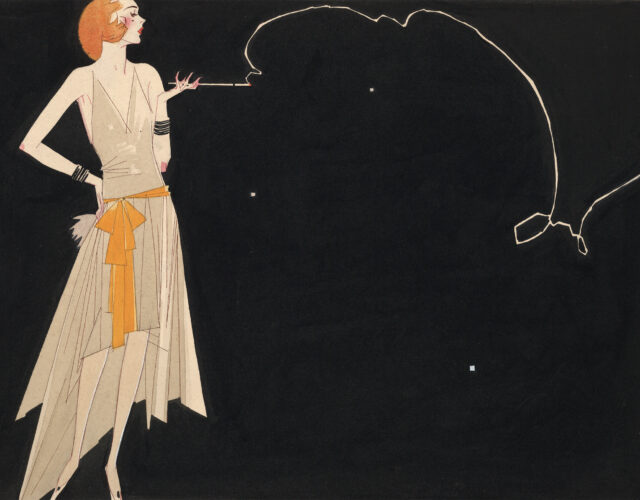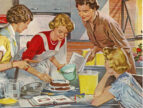Following World War I a sea change in fashion encouraged women to take thyroid extracts, exercise, and buy rolling pins that promised to “roll off the fat.” And when stronger weight loss measures were called for, calorie counting promised a failure-proof, “scientific” approach to weight loss. Yet the long life of the calorie began not in the mirror but in 19th-century laboratories and factories, an unlikely origin for something so closely tied to dieting.
The word calorie—a French-derived term denoting “unit of heat”—grew out of the notion of caloric, a fluid believed to embody heat. While caloric as a theory faded, the calorie became indispensable in the study of heat and energy in machines—especially steam engines—and later in human machines as part of food and metabolic studies. But by the end of the 1920s the calorie had become an enduring feature of American nutrition science and dieting culture, for better or worse.
Chemist Wilbur Olin Atwater brought the calorie from Germany to the United States. Born in Johnsburg, New York, in 1844, Atwater obtained a PhD in agricultural chemistry in 1869 from Yale University’s Sheffield Scientific School. He then spent two years in Germany, then the vanguard of agricultural science and physiology. Upon his return Atwater taught chemistry at East Tennessee University (now the University of Tennessee) before moving on to a lifelong professorship at Wesleyan University.
Atwater, a Victorian with a solemn countenance, pursued the study of the energy requirements of the human body at rest and in action. (Ironically, the only exception to Atwater’s otherwise austere appearance was his ample midsection, which stretched the vest of his three-piece suit.) His work on calories was part of a broader development in American nutrition science. During the 1860s scientists began to investigate systematically the chemical composition of foods, and in the 1910s and 1920s they identified a host of vitamins and minerals essential for survival. But they were particularly interested in measuring the energy (heat) value of foods, at first for livestock and later for humans. Knowledge about the heat value of foods, however, was incomplete without answers about how the body expended that energy once consumed.
From Farms and Factories to War
Large-scale agricultural production and industrialization provided the backdrop against which 19th-century scientists in western Europe and the United States studied energy expenditure. Physiologists and nutritionists argued that better nutrition and healthier bodies would result in more efficient workers, greater industrial output, and better work discipline. In turn-of-the-century Germany physiological studies on human fatigue were part and parcel of managerial aims to yield maximum productivity and efficiency in labor. In the United States the same might be said about experiments investigating calorie and nutrient requirements. In the mid-1880s, not long before the mechanical engineer Frederick Winslow Taylor began to promote his factory time and motion studies and efficiency principles for labor—later called Taylorism—Atwater was conducting dietary studies on bricklayers in Massachusetts and Connecticut. He wanted to know how many calories and grams of nutrients bricklayers required in order to perform their work—information of particular interest to industrial managers. An 1886 article published in a general-interest magazine by Edward Atkinson—industrialist and admirer of Atwater’s work—showed that this was a science already moving beyond the lab and into the market. Brickyard managers and proprietors, according to the magazine The Century, used these studies to learn which diets would “promote the largest production of brick per man at the lowest cost to the employer.”
Atwater expertly promoted his own work on calories. From 1887 to his death in 1907 he wrote extensively about calories in The Century and in many U.S. Department of Agriculture (USDA) tracts. In these publications Atwater explained what the calorie was, how many calories various foods contained, and the number of calories one should consume according to one’s sex, age, and activity level. A “woman with light exercise,” for example, required 2,300 calories per day, while a man with a corresponding activity level needed 2,830 calories, according to a Century article Atwater wrote in 1888. Part of his purpose in promoting calorie knowledge was to guide readers on what and how much they ought to be eating. But the chemist’s earnest faith in education and in applying knowledge gleaned from empirical studies to everyday life was informed by his moral judgments about how one should eat: Atwater, the son of a Methodist minister, zealously preached the gospel of thrift.
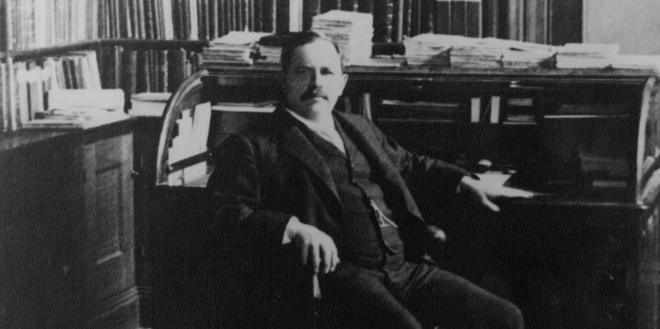
Wilbur Otin Atwater, an early promoter of the calorie, praised caloric measurement as a prudent, scientific approach to eating.
Despite a personal appearance that betrayed a robust appetite, Atwater viewed calories and food in general from a resolutely utilitarian perspective. Disconnected from pleasure and social contexts, food was simply substances used by the body to build and repair tissue, and to fuel it in its daily tasks. Consequently, he regarded excess caloric intake and extravagant spending on food to be abominable crimes of consumption, especially if one possessed limited means. In a typical instance of superciliousness—however well-intentioned he might have been—Atwater dismissed the misfortunes of those less well off by saying that “the destruction of the poor is their improvidence.”
Atwater’s calorie manifesto never reached a wide audience. (The Century was a relatively highbrow publication not typically read by the masses.) And other turn-of-the-century references to calories remained largely confined to publications in physiology, agriculture, and home economics. So while ordinary Americans might have read or heard of the word calorie by World War I, many were uncertain of its meaning. Letters to the nation’s wartime food conservation agency, the U.S. Food Administration, show that some assumed it to be “a new type of explosive discovered by the War Department.” Others who wrote to the agency at least associated it with food, believing calorie to be “the name of a new breakfast food.” Still others required guidance on how to pronounce the French-derived term. One 1918 diet guide, for example, took care to enunciate the word—“Kal-o-ri.”
Despite a personal appearance that betrayed a robust appetite, Atwater viewed calories and food in general from a resolutely utilitarian perspective.
By the end of World War I the Food Administration had turned calorie into a familiar word. The organization published pamphlets and posters encouraging Americans to ration foods shipped off to allied countries, particularly meat, wheat, and sugar. A typical poster in 1918 told Americans that “Food Will Win the War . . . Waste Nothing.” The agency also instructed Americans that they could ration food and still obtain enough calories. To consume more calories than recommended by the Food Administration’s nutrition experts for one’s respective age, sex, and activity level meant undermining both the war effort and physiological efficiency. In New York City, restaurants eager to brandish their patriotism even featured calorie counts on their menus, next to entrée descriptions and prices. The calorie also became a means by which the agency taught Americans how to ration foods and find substitutes for what they would ordinarily consume. A Food Administration pamphlet might instruct Americans to reduce their caloric intake by 200 calories or to replace the 500 calories in a slab of beef with additional servings of beans, for example.
After the war the calorie continued to infiltrate everyday life. But rather than count calories to conserve food and demonstrate their patriotism, some Americans turned to calorie counting to conform to a new bodily ideal of slenderness.
Thin Is In
Until the beginning of the 20th century Americans associated plumpness with beauty and wealth. Thinness implied illness or poverty. During the Victorian era the hourglass figure with its cinched waist, full bust, and wide hips was the most sought-after feminine form. By the 1920s a flat-chested, narrow-hipped, long-legged figure epitomized feminine beauty among the fashion-conscious flapper set. Bulk, in contrast, suggested a mélange of unwanted and conflicting attributes—dominance, aggression, and masculinity on one hand, and matronly aging on the other.
Changes in women’s clothing and fashion complemented the shift in the ideal female body. Fashion became an even mightier force in the 1920s as images of the latest styles and featherweight models—real or illustrated—reached consumers via national advertisements, motion pictures, department-store displays, and traveling fashion shows.
The new thin body signified wealth and leisure, inspiring the affluent and aspirational classes to diet. Only those with considerable means could afford to reject food, after all. Reining in one’s appetite and rejecting food while surrounded by it demonstrated privilege and steely discipline—refusing food when the body craved it was to defy one of the most fundamental of human needs. Achieving a slender physique was also a means of signaling social status. Privileged women might cultivate a frail, willowy appearance to contrast the voluntary idleness of their own bodies with the distressed bodies of the working classes. Thinness, then, formed a visible difference between the working and leisured classes.
The new thin body signified wealth and leisure, inspiring the affluent and aspirational classes to diet.
Despite the massage rolling pins, the thyroid extracts, and the exercise (though not as vigorous as that which today’s female workout warriors engage in), dieters chiefly shed pounds by regulating their food consumption. They stopped snacking between meals, skipped some meals altogether, replaced heavy foods with lighter fare, and experimented with a number of dieting fads. The Hollywood 18-Day Diet, for example, restricted dieters to a spartan ration of citrus fruits, melba toast, vegetables, and hard-boiled eggs, amounting to 585 calories per day. Calorie counting reinforced dieting practices already under way and encouraged new dieters by legitimating its promise with science.
If Atwater introduced the calorie to American nutrition science, Lulu Hunt Peters was the self-proclaimed “popularizer” of calories. A physician of the Progressive era—then an unusual profession for a woman—Peters earned a medical degree from the University of California in 1909. Her personal struggles with weight and her own relative success with counting calories informed her conviction that managing calorie consumption was the answer to weight control. By her own account Peters weighed 220 pounds at her heaviest, then lost 70 pounds through calorie restriction. Still, Peters never achieved a certifiably slender frame, such as those seen on gossamer contemporaries like the French fashion designer Coco Chanel and the infamous Duchess of Windsor (the erstwhile American divorcée, Wallis Simpson). In middle age Peters had the appearance of a perennial, intermittently frustrated dieter. But as would be expected of the doyenne of calorie counting, Peters was unmistakably fashionable. She adorned herself in conspicuous jewelry and furs. Her eyebrows were severely plucked, and her thin, pursed lips enhanced with bold lipstick. Her dark hair was bobbed and ornamented with low-hanging headbands. Everything about Peters’s physical presentation conveyed a sense of exacting obeisance to the dictates of flapper fashion. In this sense she was just like her acolytes—image-conscious and desperate to be thin.
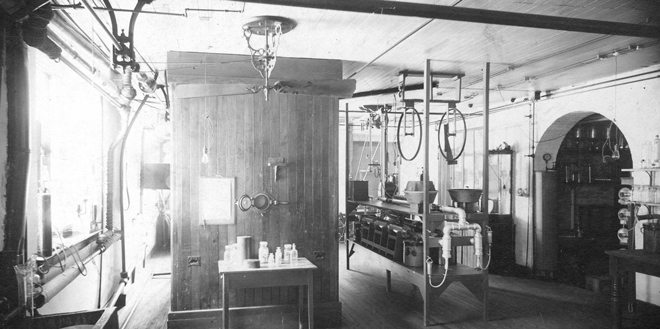
A back view of Atwater’s respiration calorimeter.
From 1918 until her death Peters promoted calorie counting for weight loss through her syndicated column and diet guides. Like Atwater, Peters was both an adept and indefatigable advocate for herself and the calorie as a precise, infallible measurement of food. But while Atwater proposed counting calories to achieve physiological efficiency and equilibrium, Peters did so primarily as a tool to manipulate one’s weight for aesthetic ends. In promoting calorie counting as a way of life, she projected an assertive, didactic voice. She lectured in Diet and Health (the book for which she is remembered), “You should know and also use the word calorie as frequently, or more frequently, than you use the words foot, yard, quart, gallon, and so forth, as measures of length and liquids. Hereafter you are going to eat calories of food. Instead of saying one slice of bread, or a piece of pie, you will say 100 calories of bread, 350 calories of pie.”
In insisting that dieters reimagine food as calories, Peters encouraged what amounted to a mathematization of dieting. Her mantra was that if dieters learned how many calories they would need to consume in order to lose weight and how many calories were contained in the foods they ate, they would be equipped to melt off the pounds. According to the diet guru, the average person should consume 15 to 20 calories per pound of body weight daily in order to maintain weight. Dieters were to subtract that total by 500 to 1000 calories a day, depending on how rapidly they hoped to lose weight. Given the tallying involved in this regimen, it was no wonder that Peters reserved pages in her diet guide for users to log their calorie counts.
In insisting that dieters reimagine food as calories, Peters encouraged what amounted to a mathematization of dieting.
Diet and Health sold like calorie-laden hotcakes. Frequently cited as America’s first best-selling diet book, the book sold 2 million copies—800,000 in hardcover—and was in continuous publication from 1918 to 1939. In 1922 alone the 105-page book went through 9 printings and topped the New York Tribune’s list of best-selling nonfiction books. By 1930, the year Peters died, the word calorie seemed to roll off people’s tongues, and even some schoolchildren were fluent in calorie counting. In 1927 one home economist observed that “in this country the calorie is a familiar word in the vocabulary of practically every adult, and anyone who doubts the possibility of popularizing it should observe a group of ten-year-old children counting their calories.”
As her book sales indicated, Peters had a substantial fan base. Her program of calorie counting made dieting seem more scientific and failure-proof. To be able to quantify and manipulate food intake accordingly gave dieters a newfound feeling of control over the size and shape of their bodies. Calorie counting, moreover, was a social pastime of sorts that women shared with their friends. In a letter dated 1922 one admirer of Peters’s column testified both to Peters’s popularity among dieters and the communal nature of calorie counting: “I can’t tell you how many of my friends are on your diet; in fact, it is one of our main discussions. Don’t we antifats love and dote on you!”
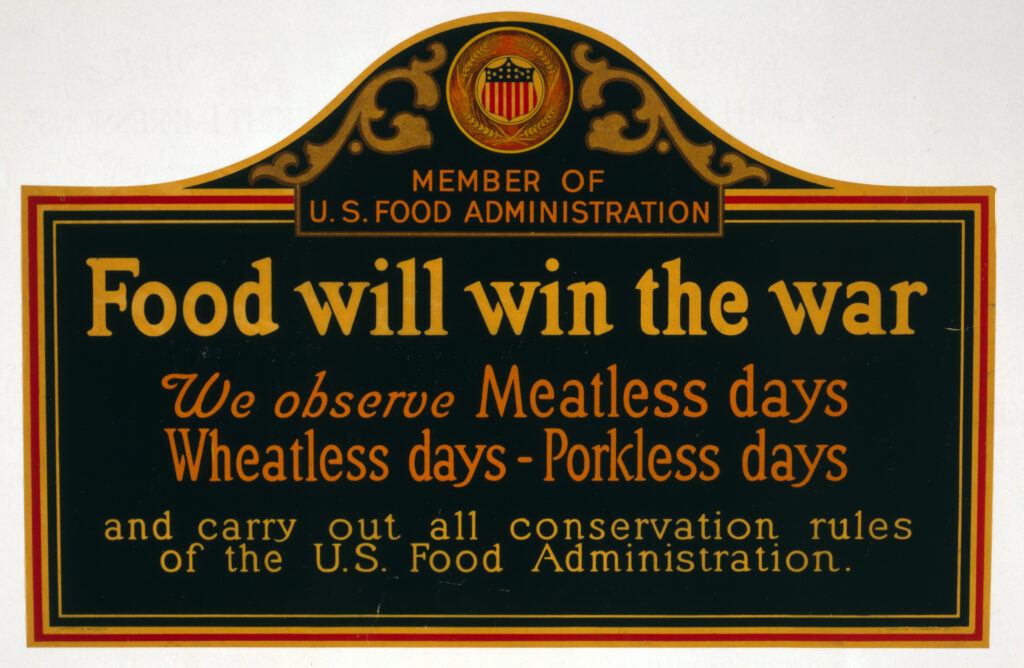
“Meatless,” “wheatless,” and “porkless” days were considered patriotic duties during World War I.
Not everyone embraced the new dieting culture of the 1920s. Some young women warned of the pernicious effects of “reducing.” At Smith College in Northampton, Massachusetts, three students fired off a letter to the editor of the student newspaper in 1924. They cautioned that “if preventive measures against strenuous dieting are not taken soon, Smith College will become notorious, not for the sylph-like forms but for the haggard faces and dull, listless eyes of her students.” Physicians similarly assailed the so-called thinness craze among young women, maintaining that dieting jeopardized women’s physical and mental well-being as well as their looks. But physicians were also disgruntled that when women bought Peters’s Diet and Health and myriad weight-loss remedies, they circumvented medical authority by failing to consult their doctors.
But these voices of opposition did little to mitigate the fledgling cult of thinness. The practice of calorie counting proliferated among legions of dieters, as the early 20th-century social forces that enabled the calorie’s transfer from nutrition laboratory to factory to everyday dieting continued through the rest of the century and into the 21st. When Lulu Hunt Peters and other experts seized upon knowledge of the calorie as central to weight loss, the calorie ceased being a relatively obscure term denoting heat value. It had metamorphosed into a body-shaping tool central to dieting.
Experimenting with Calories
To illuminate how the body expended energy from food, German physiologists Max von Pettenkofer and Carl von Voit began conducting experiments in 1866 using a respiration calorimeter, which Atwater described in an 1887 magazine article as an “iron box.” This iron-plated chamber measured 8 feet by 8 feet, had glass windows, and was just barely large enough to accommodate one adult male subject. Pettenkofer and Voit used an air pump to determine their subjects’ food and drink intake and output to learn how the body converted proteins, carbohydrates, and fats into energy. Then in the 1870s Max Rubner, a Berlin-based physiologist, measured the heat value of nutrients and calculated the amount of energy that precise amounts of nutrients registered once metabolized (4.1 kilocalories for 1 gram of protein, 4.1 kilocalories for 1 gram of carbohydrate, and 9.3 kilocalories for 1 gram of fat).
By the last quarter of the 19th century these food and metabolism studies reached the United States via Atwater, who sought to replicate and expand upon the work of the German scientists. Using bomb calorimeters—insulated vessels containing food to be burned—he and his assistant calculated the nutrient and energy values of some 6,600 foods. To determine nutrient and caloric requirements under various activity levels, Atwater and his collaborator Edward Bennett Rosa, a Wesleyan physicist, used a double-walled sheet-metal respiration calorimeter. Reminiscent of Pettenkofer and Voit’s apparatus, Atwater and Rosa’s calorimeter measured 7 by 4 feet and included a bed, desk, chair, and ergometer (machine measuring work performed) to record more than 500 instances of men’s heat and carbon dioxide output under myriad conditions, from sleep, to study, to such physical activities as vigorous cycling.

